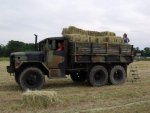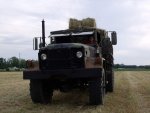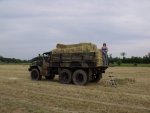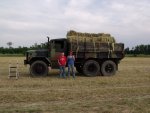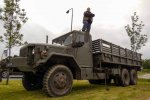All vehicles have at least one fuel tank and there is nothing you can do about that.
In 1985 I was stopped at a red light in my patrol car in Phoenix. A small compact car was stopped behind me. A school bus came up from behind, struck the compact car and forced it into my car. The fuel tank on the compact car ruptured and the car caught fire. The car was damaged too extensively to get the driver out. He was screaming like crazy because he was injured and knew he was on fire. The fire dept. was immediately summoned but would not arrive for another 3 minutes. We could not get the man out and had to watch him burn to death. The most horrible part I remember was when his hair burst into flames and his face melted.
There were no "safety" violations related to the fire, but I'm not in favor of adding fuel tanks in vulnerable locations. I think they would be fine in the bed of a deuce if well secured.
I don't think safety can ever be overstated when it comes to fuel and cars.

I disagree, yet want to make it clear that safety is very important and we all need to take it seriously, always. A statement such as “safety can ever be overstated” is improper though. How about something like “reasonable measures to ensure safely should always be followed?” Most of the public has no idea about how to understand or manage risk, deal with it effectively, etc. Unfortunately, we often succumb to an emotional response based on a tragic event rather than a reasonable response based on a series of facts, known and unknown, etc. Such as how fast was the bus traveling at then it struck a series of stopped vehicles? Why did the driver of the bus fail to stop? Was the driver impaired or distracted? Who caused this, the designer of the brake system in the school bus? This sort of thing leads to tragedies on both extremes from underreactions to overreactions.
I call your attention to the over 10 million GM trucks from 73-87 with side-mounted fuel tanks. In fact, Dateline NBC aired a so-called “investigative report” on these trucks and made a massive emotional appeal that repeatedly showed explosions and traumatic events to trigger an emotional response of the readers, thus making them believe that GM was the boogey-man. As it turns out, (forgive my memory if I goof a few details here) they crashed into ~40 trucks at increasing speeds well beyond what the program indicated AND eventually resorted to planting an explosive to make the tanks “explode.” As it turns out the program was a complete sham, yet the stain stuck with GM for many years. I’m not aware of how many real fires resulted from these trucks (and would like to know). What I think is a better and more proper question would be “How many other vehicles with and without these tanks caught fire and is the difference statistically significant?”
I also call your attention to the fact a great many medium and heavy trucks carry 50, 80, 100, even 200 or more gallon fuel tanks completely exposed on their sides! This includes Deuces and 5 Tons. And then Jerry cans on the steps. And if memory serves don’t some 5 Tons and M35A3 trucks carry Jerry cans just inboard of the front bumpers? Also, many vehicles have fuel tanks mounted inched ahead of a thin rear bumper. And then there’s the Pinto… And the Corsair…
I would like to see some statistical data showing the probability of impact to and from each side with a corresponding difference in speed at impact. The tanks have to be somewhere and it stands to reason to put them in a less vulnerable area. After all, how many of us have seen a failed driveline slice through frame crossmembers and other heavy parts? Would it be safer to mount the tanks next to the driveline? The driveline would potentially cut into the fuel tank, sending atomized fuel right onto the hot exhaust. My hunch (notice there is no presumption of fact, just a hunch) is that you’d see an elevated occurrence of stopped vehicles that are hit from the rear and maybe an elevated front fender occurrence. I’ve been rear-ended several times (on the freeway for any smart alecks), yet this is not “proof” that is most common. I’m not fond of the idea of mounting fuel tanks in the front or rear of any vehicle without adequate protection. It looks like the bumperettes stick out a foot or so past the cans. It seems the weakness, if there is one, would be what I mentioned earlier, or an impact from a vehicle about 2 feet from the ground at an angle that stabs in just at the Jerry can that also hit with a high differential speed with a hot component that is exposed during the event.
May 23 Added Note: ALL of us should have an anboard fire extingusher and know how to use it. Getting a fire out before it gets out of control or while people escape is better than focusing time on one specific possible event. There's a long list of possible things to start a fire and having a fire extingusher handy at an instant is good policy. I keep one in the cab and know exactly where it is at all times. Also, check the gage from time to time.
I’m not trying to give a professional option or poke an argument, just give some things to think about.
 Probably won't be back on for a while so Happy Memorial Day everyone!
Probably won't be back on for a while so Happy Memorial Day everyone!







 (unless I am misunderstanding your point).
(unless I am misunderstanding your point).